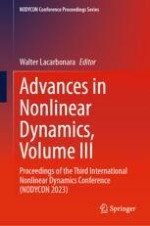This third of three volumes presents papers from the third series of NODYCON to be held in June of 2023. The conference papers reflect a broad coverage of topics in nonlinear dynamics, both traditionally placed in established streams of research as well as they stand as newly explored and emerging venues of research. These include• Multi-scale dynamics: multiple time/space scales, large system dynamics• Experimental dynamics: benchmark experiments, experimental methods,instrumentation techniques, measurements in harsh environments, experimentalvalidation of nonlinear models• Reduced-order modeling: center manifold reduction, nonlinear normal modes, normalforms• Systems with time and/or space delays• Nonlinear interactions in multi-dof systems: parametric vibrations, multiple external andautoparametric resonances.• Computational techniques: efficient algorithms, use ofsymbolic manipulators, integrationof symbolic manipulation and numerical methods, use of parallel processors.• Nonlinear system identification: parametric/nonparametric identification, data-drivenidentification• Multibody dynamics: rigid and flexible multibody system dynamics, impact and contactmechanics, tire modeling, railroad vehicle dynamics, biomechanics applications,computational multibody dynamics• Fluid/structure interaction• Nonlinear wave propagation in discrete and continuous media
